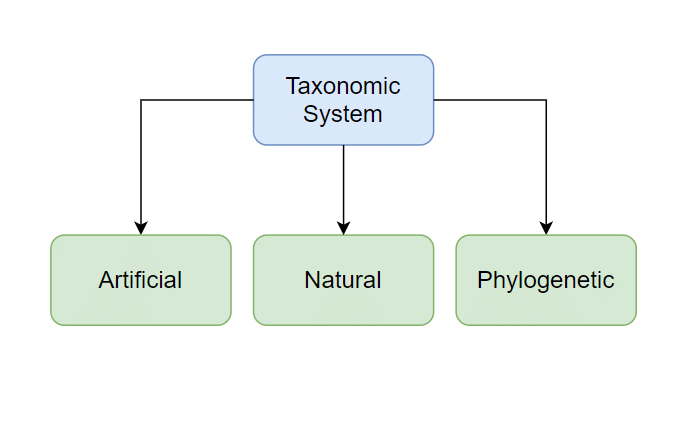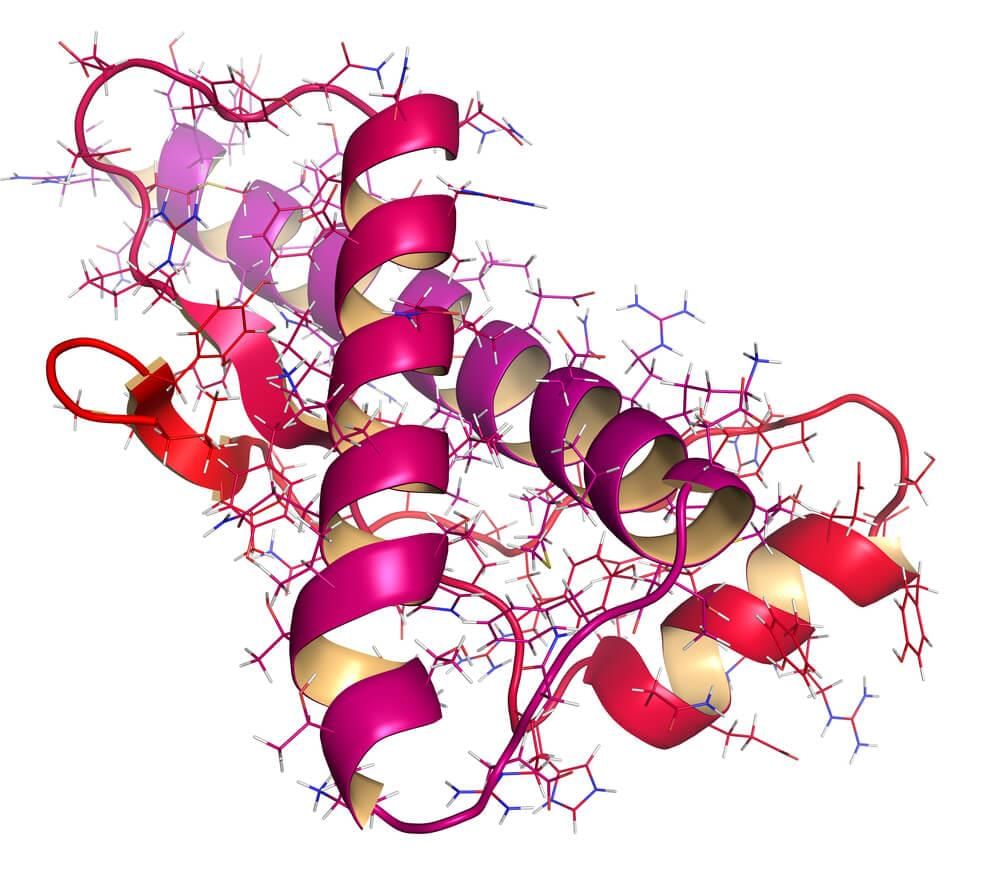Need for Classification & Three Domains of Life | Biology A-Level - A Level PDF Download
Why is there a need for Classification?
Classification is a very important aspect of Biology. It has greatly eased the study of various organisms and their evolution.
All living organisms are widely classified into kingdoms based on their particular characteristics. In this chapter, we will learn about biological classification and various kingdoms.
Types of Biological Classification
There are three main types of classification:
- Artificial
- Natural
- Phylogenetic
 Biological Classification
Biological Classification
Artificial System of Classification
- It is a system of classification which uses one or two morphological characters for the grouping of organisms. Some artificial system has used habit and habitat for this purpose.
- Aristotle (350 BC) divided animals into two categories, Enigma (with red blood) and Anaima (without red blood).
- Aristotle also classified animals on the basis of their habitat- aquatic (e.g, fish, whale), terrestrial (e.g, reptiles, cattle) and aerial (e.g. birds, bat).
- Pliny the Elder (23-79 A.D.) used an artificial system of classification for both plants and animals, dividing them into land, air and water. Pliny distinguished animals into flight and inflight ones. Flight animals included bats, birds and insects.
 The four classes of extant tetrapods, (clockwise from upper left), Rana(amphibian), Opisthocomus(bird), Eumeces(reptile) and Mus(mammal)
The four classes of extant tetrapods, (clockwise from upper left), Rana(amphibian), Opisthocomus(bird), Eumeces(reptile) and Mus(mammal)
Natural System of Classification
- It is a system of classification that considers a comparable study of a number of characters to bring out the nature of similarities and dissimilarities and, hence, the nature of the relationship among the organisms.
- The system employs those characters which are relatively constant. They include morphological characters, anatomical characters, cytological characters, physiology, ontogeny or development, reproduction, cytochemistry and biochemistry, experimental taxonomy, etc.
- The characteristics are helpful in bringing out a maximum number of similarities in a group and comparable differences with another group of organisms. For example, mammals are characterized by the presence of mammal. Birds possess wings, feathers, pneumatic bones, ovipary, 4- chambered. They are cold-blooded.
Phylogenetic System of Classification
- Classification based on the evolutionary relationship of organisms is called a phylogenetic system of classification. It is based on Darwin’s book's evolutionary concept- "On the origin of species" by means of natural selection.
- The preservation of favoured races in the struggle for life (1859). It reflects the true relationships among the organisms.
- The first phylogenetic system was proposed by Engler and Prantl (1887-99). Since similarity in structure represents a close evolutionary relationship, geologists believe that their natural classification represents evolutionary and phylogenetic classification.
History of Classification
Aristotle
Father of biology & father of zoology.
Theophrastus
- He is known as the father of ancient plant taxonomy and the father of botany.
- Theophrastus wrote many books on 'plants'.
- Few of them are as follows:
(i) Historia Plantarum
(ii) Causes of plants
(iii) Enquiry into plants
 Statue of Theophrastus, Palermo Botanical Garden
Statue of Theophrastus, Palermo Botanical Garden
- Theophrastus gave names and descriptions of 480 plants in his book "Historia Plantarum".
- Theophrastus proposes the first classification of the plant kingdom.
He classified the plant kingdom into four groups on the basis of growth habit:(i) Trees
(ii) Shrubs
(iii) Under shrubs
(iv) Herbs
Carolus Linnaeus [1707 – 1778]
- He is known as the father of taxonomy, father of plant taxonomy and father of animal taxonomy.
- Linnaeus gave the two-kingdom system classification. He grouped plants and animals into kingdom Plantae and kingdom Animalia, respectively.
- Linnaeus wrote many books.
- Some important books are:
(i) Hortus Uplandicus - First book
(ii) Flora japonica
(iii) Philosophia Botanica
(iv) Critica botanica
(v) Systema Naturae (1737)
(vi) Genera Plantarum
(vii) Species Plantarum - last book (1753)
Statement-2 : Aristotle divided animals into group - Anaima and Enaima.
A.P. De Candolle
- He wrote the book - "Theories Elementaire de la Botanique”. He was the first to propose the significance of vascular tissue in taxonomy.
- On this basis of vascular tissue, he classified plants into two groups:
(i) Cellular plants (Non-vascular plants)- This group includes Thallophyta and Bryophyta.
(ii) Vascular plants- This group includes Pteridophyta, Gymnosperm and Angiosperms.
George Bentham (1800 -1884) and Joseph Dalton Hooker (1817 -1911)
- Both Bentham and Hooker were related to the Royal botanical garden.
- They wrote the book "Genera Plantarum" (1862 - 1883).
- In this book, Bentham and Hooker gave the biggest and natural classification of Spermatophyta, i.e. plants with seeds.
- In Genera Plantarum, there is a description of 202 families. In it, basically, the description of plants with seeds is present.
A. W. Eichler
- Syllabus de Vorlesungen uber phanerogamen Kunde - Book written by Eichler.
- In this book, Eichler gave the first phylogenetic classification of the plant kingdom.
- The classification of Eichler is very little phylogenetic.
Engler (1844 - 1930) & Pranti (1849 - 1893)
- Book - "Die Naturlichen Pflanzen Familien".
- He gave the phylogenetic classification of the plant kingdom. This classification was more phylogenetic as compared to Eichler's classification.
Oswald Tippo
- Proposed the biggest phylogenetic classification of the plant kingdom.
- This classification is the complete classification of the plant kingdom.
- This is the most acceptable classification for books and study.
- Phylogenetic classification of the plant kingdom:
(i) Cyanophyta: B.G. Algae
(ii) Euglenophyta: Euglenoids
(iii) Chlorophyta: Green algae
(iv) Chrysophyta: Yellow-green algae
(v) Pyrrophyta: Dinoflagellates & Diatoms
(vi) Phaeophyta: Brown algae
(vii) Rhodophyta: Red algae
(viii) Schizomycophyta: Bacteria
(ix) Myxomycophyta: Slime moulds (False fungi)
(x) Eumycophyta: True fungi
Karl Menz
- He showed the importance of serology in taxonomy.
- Similarities and dissimilarities in the structure of proteins help to know the phylogenetic relationship of living beings.
- Living organisms which are phylogenetically close relatives have more similarities in their proteins.
- Organisms which are distantly related have different proteins.
Haeckel
- Haeckel gave the three kingdom (Protista, Plantae, Animalia) system of classification.
- Haeckel established the kingdom Protista.
- Haeckel grouped those living organisms in Protista which did not have tissues.
- Kingdom Protista: Prokaryotes, Protozoa, Porifera, Algae & fungi.
Five Kingdom Classification (from 1969 to 1990)
In order to develop phylogenetic classification, R.H. Whittaker (1969), an American taxonomist, divided all the organisms into five kingdoms. As the viruses are on the borderline of living and non-living, they have been left out.Whittaker has used five criteria for delimiting the different kingdoms:
- The complexity of cell structure, prokaryotic and eukaryotic.
- The complexity of body structure or structural organization, unicellular and multicellular.
- Mode of nutrition which is divergent in multicellular kingdoms-photoautotrophy in Plantae, absorptive heterotrophy in fungi and ingestive heterotroph on Animalia. Photoautotrophy nutrition is also called holophytic nutrition, while ingestive heterotrophy is known as holozoic nutrition. An absorptive heterotroph is a probiotic (=saprophytic ) nutrition.
- Ecological lifestyle like producers (Plantae), decomposers (fungi) and consumers (Animalia).
- Phylogenetic relationships.
- Whittaker’s five kingdoms are Monera, Protista, Plantae, Fungi and Animalia.
Table: Characteristics of Five Kingdom

Three Domains of Life (Six Kingdom Classification) - 1990
The three-domain system is a biological classification which was introduced by Carl Woese, a professor in the department of microbiology, University of Illinois, Urbana- Champaign in 1990 that divides cellular life forms into archaea, bacteria and Eukarya domains. Three Domains of Life
Three Domains of Life
- It emphasizes the separation of prokaryotes into two groups, originally called eubacteria (now bacteria) and archaebacteria (now archaea). Because of their fundamental differences, Woese argued that each of the two arose separately from an ancestor with poorly developed genetic machinery, often called a progenote.
- In fact, the three-domain system is loosely based on the traditional five-kingdom system but divides the monera into two ‘’domains’’, leaving the remaining eukaryotic kingdoms in the third domain.
- It is actually a six-kingdom classification. (Explained Below).
Archaea Domain
The domain contains prokaryotic organisms which have a monolayer core of lipids in the cell membrane and distinct nucleotides in their 16S rRNA. It contains a single kingdom.
Kingdom Archaebacteria: The kingdom contains early prokaryotes which live in extreme environments.
Example:
- Methanogens- metabolize hydrogen and carbon dioxide into methane.
- Halophiles- Live in salt.
 Halophiles
Halophiles
- Thermoacidophiles- live in acid high temperatures (up to 110 degrees Celsius).
Bacteria Domain
- The domain contains prokaryotes that lack membrane-covered cell organelles but do have microchambers for separating various activities. There is a single kingdom.
- Kingdom eubacteria: The domain contains a diverse type of bacteria having a peptidoglycan cell wall, glycogen as a food reserve, naked DNA coiled to form nucleoid, the absence of sap vacuoles and the presence of 70S ribosomes. Some common groups are bacteria, mycoplasma, actinomycetes, rickettsiae, spirochaetes, firmicutes, cyanobacteria.
Eukarya Domain
The domain contains eukaryotic organisms which originated by the endosymbiotic association between some archaebacteria and eubacteria.
It has four kingdoms- Protista, Fungi, Plantae and Animalia.
Viroids (L. Virus- Point, EIos – Diminutive)
- They are the smallest self-replicating particles which were discovered by Diener (1971).
- They are obligate parasites.
 Structure of Viroids
Structure of Viroids - The molecular weight of a viroid is low.
- The RNA is tightly folded to form a circular or linear structure.
- Viroids are known to cause diseases (some 20) in plants only, e,g, potato spindle tuber, chrysanthemum stunt. Animal or human infection is not known.
- Viroid production is not very clear. Viroids particles can multiply by both RNA development and DNA dependent replication.
Prions (Prusiner, 1983)
- They are highly resistant glycoprotein particles which function as infectious agents.
- They are formed due to a mutation in gene PRNP.
- They can also act as a catalyst in converting normal protein into a prion state.
 Prion
Prion
- Prions are not affected by proteases, nucleases, for temperature up to 800°C, UV radiations and formaldehyde.
- Prions accumulate in nervous tissue and bring its degeneration. Common diseases caused by them are scrapie of sheep, mad cow disease, Creutzfeldt-Jakob disease (CJD) and kuru.
|
280 videos|166 docs|147 tests
|
FAQs on Need for Classification & Three Domains of Life - Biology A-Level - A Level
| 1. Why is there a need for Classification? |  |
| 2. What are the types of Biological Classification? |  |
| 3. What is the History of Classification? |  |
| 4. What is the Five Kingdom Classification? |  |
| 5. What are the Three Domains of Life? |  |

|
Explore Courses for A Level exam
|

|


















